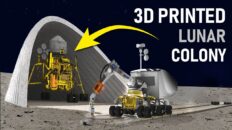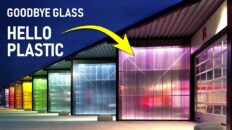The construction industry is undergoing a seismic shift. Although it was once perceived as traditional and slow to change, we are seeing a fresh wave of creativity, innovations and technological advancements.
Introduction
One of these exciting new innovations is the LADA CUBE panel system. These Lego-like walls are made of modular metal cassettes that lock together to form interior walls. They are highly versatile, infinitely reusable, mobile, and customizable. They also eliminate construction waste, which is a huge problem in our industry. Throw out everything you know about how walls are built because this system turns walls into modular, prefabricated products.
Tucked away in Grand Junction, Colorado, Lada Cube’s factory stands as one of the epicenters of industrialized construction. Their innovative building system aims to improve productivity through increased mechanization and automation. Their structural modular walls can be assembled with ease and minimal work. The walls are engineered to hold insulation, plumbing, electrical, HVAC and other utilities. Entire walls can be disassembled and their parts reused either when it’s time to reconfigure a space or in the case of a more complete demolition.
Modular Construction
Designers and builders have been exploring the LEGO-inspired concept of modular construction for several decades. By manufacturing building components offsite in controlled environments, it’s possible to reduce construction times, mitigate risks, lower labor requirements, and more. But here’s the issue; most modular construction companies continue to rely on traditional materials and building practices.
They still use wood studs and drywall. They still tape and mud every seam and texture walls.
In their approach, walls remain just as permanent and there’s no drastic change in the overall appearance of structures. While this can be comforting when transitioning to a new way of building, it’s not always the best. What makes Lada Cube stand out is that they’re not just following the crowd. They’re asking the tough questions about how walls are engineered and built, how they fit together, and they’re even rethinking the whole idea of “permanence.” Can we have walls that are as strong and solid but can be taken apart with ease at the end of their life? Can we recycle those walls and put them back into the building materials loop?
Components
- To achieve this, they have come up with standard wall cassettes in various widths including 6, 12, 18 24, 36 and 48 inches.
- They can build nearly every wall configuration with these sizes. Each cassette consists of 3 main parts.
- The side frames are made of custom rolled steel studs. The panel is completely reversible so either side can be the interior face. The second component are steel channels that connect the two side frames. They also act as blocking to stiffen the panel and provide additional surfaces to screw into.
- The panel has double insulation cavities; one of either side of the mid panel that can be made of different materials including white PVC or polyvinyl chloride, brown MDF or medium density fiberboard and translucent polycarbonate.
Camlock System
ou might be wondering how these panels connect to one another. They don’t need nails, screws or adhesives. The entire wall system comes together with a brilliantly designed camlock system.
A cam lock system comes in pairs; a male camlock latch and a female camlock receptacle. To connect the 2 panels all you need to use is an Allen wrench. A simple twist of the wrench causes the male camlock latch to grasp the female camlock pin and pull the panel in tight for secure coupling. The system is quick and easy to assemble and disassemble for fast set up and tear down. It’s also much easier than using nails or screws.
Walmart has been using these Lada Cube panels in their vision centers for the past couple of years. They can be installed in just 3-4 days with minimal disruption. When Walmart is ready to redesign the space, the panels can be easily dismantled, shipped across the country and reassembled at a different store.
Advantages
- The walls are a zero waste product. Every stud is custom made and assembled in a factory. Any excess material can be recycled and used to make new steel studs. Because of the camlock mechanism, there is minimal damage to the walls after deconstruction. If there was ever a product that qualified for a cradle to cradle certification, this is it.
- Lada Cube has a grand vision of establishing a buy-back program. After the walls are deconstructed, the owner or client would be able to sell the cassettes back to Lada Cube or to other project owners. Think of it as a Facebook Marketplace for wall cassettes.
- Another advantage of the system is the speed of install and cleanliness of job sites.
- Another advantage of the system is that it’s future proof. The corner posts that connect 2 walls can also accommodate walls in the other 2 directions in the future.
- The walls are also designed so you can run electrical wires through pre-drilled holes on either the front or back side of the panel. Lada Cube has proprietary plug and play electrical boxes that work perfectly with their modular system.
- Other utilities like water lines, drains and vents are also incorporated into the design of the panel.
Conclusion
The system is more expensive than conventional modular walls because they have yet to produce components in large quantities. They need to find more applications where this system can work. Buildings have a long lifespan, so it’s difficult for clients to think about disassembling the structure in 50 years. While the inner structural walls are an engineering marvel, the outer panels and the cleat system design need a lot of work. Seams don’t align and the panels are straight. Fortunately, the CEO John Fay and the rest of his team are continuously working on improving the system and making it user-friendly for the rest of the players in our industry.





